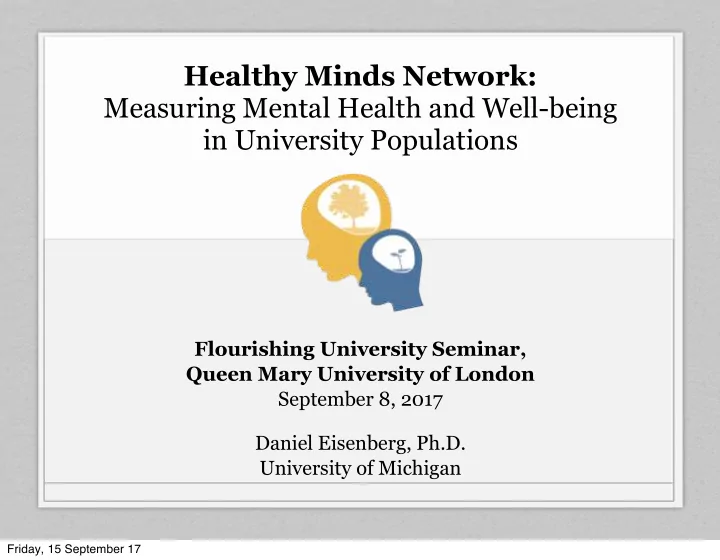

Healthy Minds Network: Measuring Mental Health and Well-being in University Populations Flourishing University Seminar, Queen Mary University of London September 8, 2017 Daniel Eisenberg, Ph.D. University of Michigan Friday, 15 September 17
Agenda I. About the Healthy Minds Network (HMN) II. Survey Data (Healthy Minds Study) III. Economic Case for Student Mental Health IV. Related Projects Friday, 15 September 17
I. About the Healthy Minds Network (HMN) II. Survey Data (Healthy Minds Study) III.Economic Case for Student Mental Health IV. Related Projects Friday, 15 September 17
Long-Term Agenda How to invest most efficiently in mental health (and success and wellbeing) in student populations? Practitioners Design and evaluate Administrators programs and Policymakers interventions Students Collect descriptive population data Friday, 15 September 17
Development of the Healthy Minds Network 5 Friday, 15 September 17
Dissemination Strategies Webinar series Research briefs Data reports Data interface (data.healthymindsnetwork.org) College Mental Health Research Symposium Partnerships (e.g., Active Minds, Jed Foundation, Center for Collegiate Mental Health, health IT companies etc.) Friday, 15 September 17
Data Reports Friday, 15 September 17
I. About the Healthy Minds Network (HMN) II. Survey Data (Healthy Minds Study) III. Economic Case for Student Mental Health IV. Related Projects Friday, 15 September 17
Healthy Minds Study Began in 2005 � >150 campuses � >200,000 survey respondents � Main Topics Mental health (e.g., depression, anxiety, self-injury, suicidality, positive � mental health) Lifestyle and health behaviors (e.g., substance use, exercise, sleep) � Attitudes and awareness � Service utilization � Academic and social environment � 9 Friday, 15 September 17
~35% of Students Have an Apparent Mental Health Problem 100 75 50 35 25 16 16 12 10 8 8 7 0 Mild dep (PHQ-9) Major dep (PHQ-9) Moderate anx (GAD-7) Severe anx (GAD-7) Eating disorder (SCOFF) NSSI Suic. ideation Any problem Source: HMS 2007-2014 Note: Anxiety and eating disorders estimates based on 2013 and 2014 data only. Friday, 15 September 17
Prevalence of Mental Health Problems Increasing Over Time (?) Friday, 15 September 17
Large Variations across Campuses in Prevalence of Mental Health Problems Friday, 15 September 17
Comparisons Across Institutions (example: University of Michigan) Friday, 15 September 17
<50% of Students with Mental Health Problems Receive Treatment 100 75 53 53 47 45 50 42 40 39 31 25 0 Mild dep (PHQ-9) Major dep (PHQ-9) Moderate anx (GAD-7) Severe anx (GAD-7) Eating disorder (SCOFF) NSSI Suic. ideation Any problem Source: HMS 2007-2014 Note: Anxiety and eating disorders estimates based on 2013 and 2014 data only. Friday, 15 September 17
Even When Received, Treatment is Often Inadequate • Among students with significant symptoms and treatment in past year, 57% received “minimally adequate” depression care • “minimally adequate” =4+ psychotherapy visits or 2+ months of antidepressant medication • Among all students with past-year depression, 22% received minimally adequate care Eisenberg, D., Chung, H. (2012). Adequacy of Depression Treatment in College Student Populations. General Hospital Psychiatry, 34 (3): 213- 220. 15 Friday, 15 September 17
Expansion of Survey in 2016 through Modular Format Friday, 15 September 17
I. About the Healthy Minds Network (HMN) II. Survey Data (Healthy Minds Study) III. Economic Case for Student Mental Health IV. Related Projects Friday, 15 September 17
Longitudinal Study: How does mental health predict academic success? � Data: random sample of undergraduate and graduate students Baseline: 2005 (N=2,798) Follow-up: 2007 (N=747) � Outcomes: GPA, retention, credit hours � Mental health: Depression (PHQ-9), anxiety (PHQ), eating disorders (SCOFF) � Reference: Eisenberg, Golberstein, Hunt (2009). Mental Health and Academic Success in College. BE Journal of Economic Analysis & Policy . Friday, 15 September 17
Economic Case for Mental Health Services Cost < $1 million 1000 students +40 students +$2 million +$8 million Friday, 15 September 17
Research-Practice Agenda How to invest most effectively in student mental health? 20 Friday, 15 September 17
Friday, 15 September 17
“Gatekeeper Training” Programs • Evaluation of Mental Health First Aid (MHFA) training for resident advisors (RAs) • PIs: Daniel Eisenberg and Nicole Speer • Funder: NIMH RC1 (2009-2011) • 32-campus randomized trial to assess impacts on student communities • Results in Lipson et al. (2014 J Adolescent Health ) 22 Friday, 15 September 17
Investing in Mental Health: Opportunities to Do Better Friday, 15 September 17
More Information Daniel Eisenberg: daneis@umich.edu Healthy Minds Network team: healthyminds@umich.edu Website: www.healthymindsnetwork.org Friday, 15 September 17
Recommend
More recommend